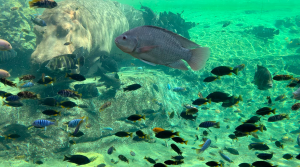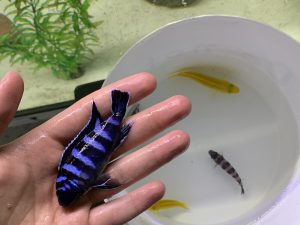Have you ever stared closely at fish in an aquarium? Isn’t it just amazing to look at the plethora of shapes, colors, and different behaviors that the fish, living on the other side of the glass, display? My younger self really enjoyed the wonders of the aquarium hobby – I believe the underwater world bears some of the world’s most amazing representations of life, and those tanks could, in some way (ethical issues aside), depict a little part of these marvels. But, how do fish see each other? Are they attracted to the colors other fish display? If so, what happens then, in the dark?
I am Adrián Colino Barea, a Spanish wildlife biologist, and a current first year student of the Master’s Programme in Ecology and Evolutionary Biology at the University of Helsinki. My main motivation to join this programme here was to dig deeper in applied ecology in tropical regions, as the University of Helsinki has several research lines in the tropics. I am aiming to focus on biodiversity conservation: I want to contribute and make a difference to revert the trends that current human-driven impacts have on nature globally.

While my passion has always been working on the field, touring the fish room of the Integrative Evolutionary Biology (IntEvoBio) lab during an introductory course of the master’s last year awakened my younger self thrill. Racks with tens of tanks full of cichlid fish from the African Great Lakes fill the room, all around us, while some of the IntEvoBio lab members, led by Prof. Claudius Kratochwil, guided us through the nuts and bolts of their interesting job with all these fish, and why they are so particularly wonderful.
African cichlids: the book example of speciation
The African Great Lakes are three massive freshwater bodies in tropical West Africa, originated by ancient tectonic shifts. However, these lakes have borne livable conditions for a relatively short time. A certain group of cichlid fish got to these waters and started evolving at an unprecedented rate, fitting every possible niche, and generating entire, complex ecosystems, all based in different cichlids. What is more, they display very different color patterns of colors, bands, and spots, and perform elaborated mating rituals. Their unusually fast evolutionary process is based in ‘sexual selection’, meaning that individuals choose others as partners based on certain traits of their preference, despite the fact that these traits could make them, for instance, more showy – and therefore easier to spot by predators, hence against ‘natural selection’ as described by Charles Darwin.
To put it in perspective, for any evolutionary biologist, the cichlids of the African Great Lakes are old acquaintances, and for some they are the entire reason for their research. For many biologists, they are just inexplicably special. Some even say that the basis of evolution today would be radically different, had Darwin visited these lakes instead of the Galápagos Islands almost 200 years ago, and looked to these fish.
While in the lab, I enjoyed seeing all of the complexity that I have read about, right before my eyes. The researchers explained to us how these fish (and their evolutionary process) strongly rely on color communication. They have developed color signaling to inform about their sexual status, the hierarchy within a group, and even some species can change their colors rapidly, to give fast information!

However, one of the drawbacks to this very fast evolutionary process is that it is also very fragile, as species may seem radically different in colors and shapes but have very similar DNA, because of how recently they have evolved. In addition to this potentially fragile evolution, these lakes are particularly vulnerable to the impacts of human development. Lake Victoria is the second-largest lake on the planet by area and a huge population increase, has led to 40 million people now inhabiting the coastal region This human activity has resulted in major issues related to biodiversity, mostly through pollution, overfishing, and introduction of invasive predator fish and floating plants.
How does sexual selection work under deterred underwater light conditions?
In particular, an invasive floating plant, the water hyacinth (Pontederia crassipes), is causing terrible damage to all ecosystems in Lake Victoria, and migh spread to other lakes. These plants prevent light from penetrating, hindering the oxygen production in the water and making the ecosystems within it collapse. Moreover, the human communities around the lake cannot physically access their resources because of how dense and inexpugnable the floating mats are.
But, coming back to my initial concern, floating plants – as well as increases in turbidity – make the underwater dark. Is there anything happening directly to the cichlids? If they rely so strongly on visual communication for their daily lives and long-term evolutionary process, how do they cope under a scenario in which their vision – light supply – is hindered? How can they find and recognize each other effectively and ‘sexually’ select their preferred partners according to visual signals (colors)?

Back during my lab visit, I asked some researchers and they didn’t have an answer. This visit was inspiring enough to raise meaningful biological questions, with profound biodiversity conservation meanings. I am very pleased that HiLIFE gave me the chance to shed light on this topic, by granting me a Research Trainee Scholarship. Since March, I can call Prof. Claudius Kratochwil my supervisor, and some of the PhD students that once showed me through their research, my helpful mentors.
From March to today: the beginning of my experimental phase
During these months, I have been setting up my experimental arena, and dedicatedly come up with a protocol to follow. I am working on the mate choice of cichlid males over females under different light conditions. Only last week I started the experimental phase, and I am excited to know what will happen with the results that I am obtaining – I will keep you posted on my progress. If this experiment arise meaningful outcomes, these invasive floating plants would potentially be given a new threat to nature, and hopefully a new reason to focus efforts and find an effective solution in the field, for the cichlids, for the people in the region, and for the entire ecosystems.

One Reply to “On how colorful fish fall in love in the dark”
Comments are closed.